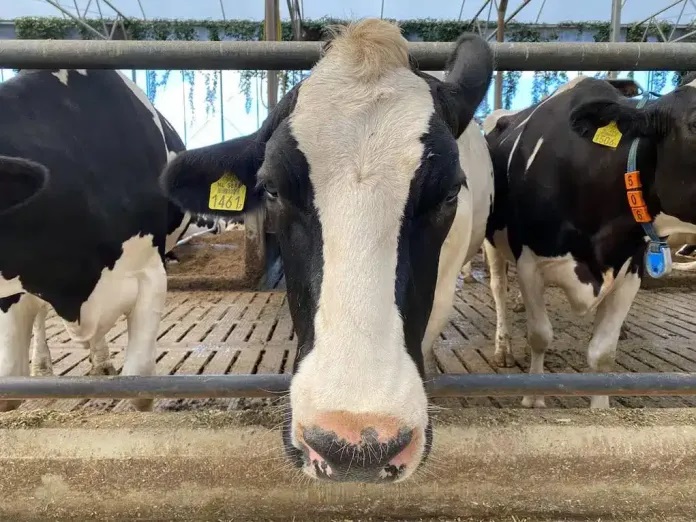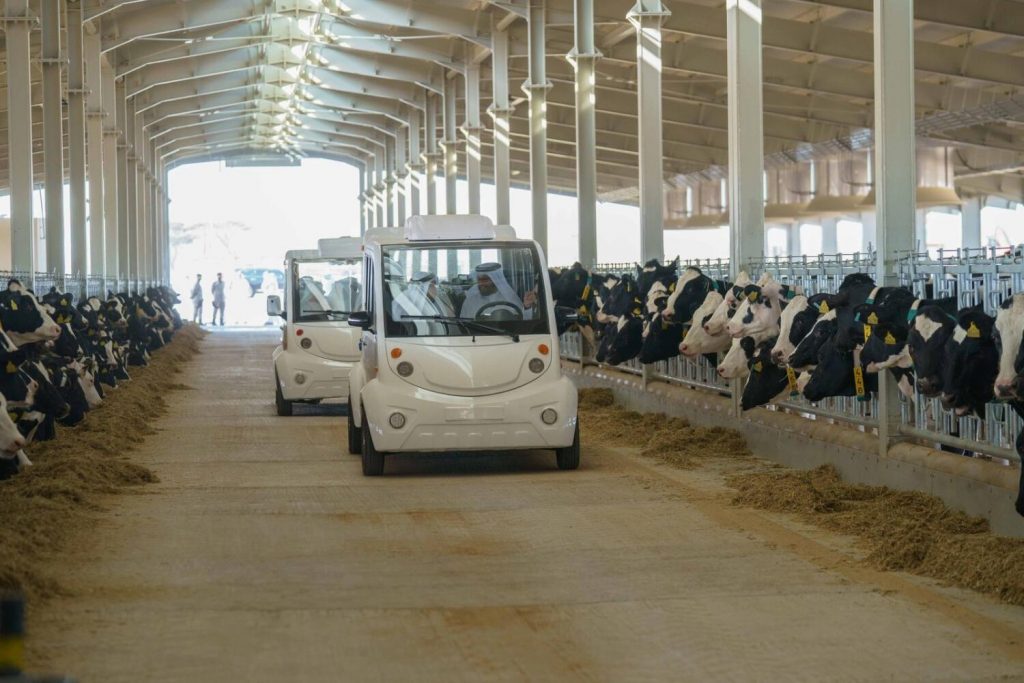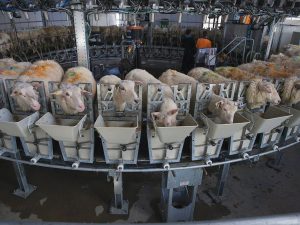Restrictions on dairy cattle movement are in place in Alabama, Arizona, Arkansas, California, Delaware, Florida, Hawaii, Idaho, Kentucky, Louisiana, Maryland, Mississippi, Nebraska, North Carolina, Pennsylvania, Tennessee, Utah and West Virginia.
The American Association of Bovine Practitioners says this infection in cattle is not the same as the highly pathogenic avian influenza (HPAI) and referred to it as Bovine Influenza A Virus (BIAV).
Speaking in the April 15 “Dairy Radio Now” broadcast, HighGround Dairy economist Betty Berning said dairy cows get sick but can and do recover, unlike poultry flocks where the birds are euthanized or die rapidly.
Transmission method is still unclear, according to Berning. “We know it originates in wild waterfowl and that’s how the cows were getting sick but not much is known beyond that.” USDA says it may be transferred by milking equipment, people milking the cows, or both. Dairies are encouraged to limit bird exposure and all traffic into and out of farm properties. There continues to be no concern about the safety of the U.S. milk supply.
The Agriculture Department lowered its milk production forecast in its sixth consecutive World Agriculture Supply and Demand Estimates report. The 2024 forecast was reduced due to slower expected growth in milk per cow. Cow numbers were unchanged from last month’s report.
2024 production and marketings were projected at 226.3 and 225.3 billion pounds respectively, down 1 million pounds on both from last month’s estimate. If realized, both would be down 100,000 pounds or 0.04% from 2023.
Fat basis imports for 2024 were raised on higher expected butter and cheese imports. Skim-solids basis imports were raised for a number of dairy products. Fat basis exports were raised on strong international demand for butter and price competitiveness of U.S. cheese. Skim-solids basis exports were lowered as fewer expected shipments of lactose and whey products more than offset higher shipments of nonfat dry milk (NDM) and cheese.
Butter prices for 2024 were raised on observed prices and continued strength in demand. Cheese, NDM and whey prices were all lowered on recent prices.
The Class III milk price forecast was lowered due to lower cheese and whey price forecasts, while the Class IV price was raised due to higher butter prices more than offsetting lower NDM prices.
The 2024 Class III price was projected to average $16.20 per hundredweight, down 95 cents from last month’s estimate, and compares to $17.02 in 2023 and $21.96 in 2022.
The Class IV average, at $20.40, is up 30 cents from a month ago, and compares to the 2023 average of $19.12 and $24.47 in 2022.
This month’s U.S. corn outlook is for greater use for ethanol and feed and residual use and smaller ending stocks. Corn for ethanol was raised 25 million bushels to 5.4 billion. Feed and residual use was increased 25 million to 5.7 billion. Ending stocks were lowered 50 million bushels to 2.1 billion. The season average farm price was lowered 5 cents to $4.70 per bushel.
The soybean outlook includes lower imports, residual, exports and higher ending stocks. Soybean trade was reduced on pace to date and expectations for future shipments. Soybean ending stocks were raised 25 million bushels to 340 million. The season-average soybean price was forecast at $12.55 per bushel, down a dime. Soybean meal and oil prices were unchanged at $380 per short ton and 49 cents per pound, respectively.
The USDA’s latest Crop Progress report shows 3% of the U.S. corn crop was in the ground, as of the week ending April 7, dead even with a year ago and 1% ahead of the five-year average.
The week ending March 30 saw 56,700 dairy cows go to slaughter, down 900 from the previous week, and 10,100 or 15.1% below a year ago. Year to date, 871,500 head have been culled, down 123,700 or 14.2% from a year ago.
February milk production was down 1.3% from a year ago, factoring the Leap Day, and the February Dairy Products report shows how that played out.
Cheese production fell to 1.133 billion pounds, down 5.6% from January but up 3.0% from February 2023, down 0.6%, when factoring the Leap Day. The January total was revised up 10 million pounds. Production for the first two months of 2024 totaled 2.3 billion pounds, up 1.2% from 2023.
StoneX says cheese production was 7 million pounds lower than they expected, most of it coming in cheddar while mozzarella output was closer to forecasts. “Usually this large of a drop in cheddar production is bullish for the market.”
Wisconsin provided 283.3 million pounds of the total, down 6.5% from January but 4.0% more than a year ago. California produced 200.9 million pounds, down 4.1% from January and 0.5% below a year ago. Idaho, with 76.6 million pounds, was down 11.7% from January but 5.8% above a year ago. New Mexico, at 75.7 million, was down 7.6% from January but 2.2% more than a year ago.
Italian cheese production was down 6.2% from January but 4.4% above a year ago, not factoring the Leap Day. American output was down 7.5% from January and 1.2% below a year ago. Mozzarella was 3.2% from a year ago.
Cheddar output plunged to 304.9 million pounds, down 25.7 million pounds or 7.8% from the January level, which was revised up 4.5 million pounds, and was down 12.2 million pounds or 3.8%, from a year ago. Year to date cheddar is down 5.3%.
Butter production dropped to 197.6 million pounds, down 19.6 million pounds or 9.0% from January’s total which was revised up 3 million pounds but was up 10.4 million pounds or 5.6% from a year ago. Butter was up 1.9%, accounting for the Leap Day. Year to date butter is at 414.9 million pounds, up 6.8% from a year ago.
Yogurt production totaled 399.1 million pounds, down 0.4% from a year ago, with year to date output at 796.7 million pounds, up 0.6%.
Dry whey production slipped to 72.1 million pounds, down 5.6 million pounds or 7.2% from January, but was up 5.3 million pounds or 7.9% from a year ago. YTD whey stands at 149.9 million pounds, up 4.4%. Stocks grew to 72.9 million pounds, up 5.4 million or 8.0% from January and 3.9 million pounds or 5.7% above those a year ago.
Nonfat dry milk output jumped to 147.4 million pounds, up 9.1 million or 6.6% from January but was 35.1 million or 19.3% below a year ago. Year to date powder was at 285.7 million pounds, down 20.1%. Stocks fell to 209.6 million pounds, down 2.7 million or 1.3% from January, and down a whopping 106.2 million pounds or 33.6% from 2023.
Skim milk powder production dropped to 36.2 million pounds, down 20.7 million pounds or 36.3% from January, and 1 million or 2.6% below a year ago.
StoneX called the nonfat-skim milk powder production bullish. “Total powder production was down nearly 20% from last year which contributed to the 33.6% decline in inventory volume from 2023 levels.” “Given the data in this report it seems February milk production may have been a bit overstated,” concluded StoneX, “As there were a lot of solids that would have gone missing for these production numbers to have occurred.”
CME block cheddar climbed to $1.57 per pound Tuesday, highest since Feb. 29, then lost 6 cents Thursday but rallied Friday and finished at $1.5350, up 2 cents on the week but 24 cents below a year ago.
The barrels marched to $1.5675 Monday, then back tracked some, but also rallied Friday to close at $1.5725, highest since March 6, up 4.25 cents on the week, 6 cents above a year ago, 3.75 cents atop the blocks. CME sales totaled 44 loads of block on the week, 21 on Friday alone, and 20 of barrel.
Milk accessibility is wide open in the Upper Midwest, says Dairy Market News (DMN), and mid-week spot milk prices were as low as $6-under Class. Cheese plant downtime remains a factor. Cheesemakers’ demand notes vary from slightly slow to slightly active though barrel interest has quieted. Inventories are not yet a concern in the region. Retail cheddar and Italian style cheesemakers say demand is somewhat steady. Customers within and outside of the region are returning as market tones were beginning to display quietly bullish indications.
Cheese makers note strong production in the West. Milk output is strengthening with the seasonal spring flush. Plenty of inventory is available. Demand is steady to lighter and some report production continues to outpace demand. Export demand is steady to moderate as international buyers are buying more for immediate to short term delivery, according to DMN.
Butter flirted with the $3 level, hitting $2.97 per pound Monday, highest since Nov. 6, 2023’s $3.01, but fell to $2.8925 Thursday and closed Friday at $2.92, 2 cents lower on the week and 59.25 cents above a year ago, on 14 sales.
Central butter makers shared similar sentiment to previous weeks, but changes are afoot regarding near term production plans. Growth in inventories after consecutive months of widely available cream has some producers expecting to throttle down churning the next few weeks. Demand is holding but cream remains widely accessible, as multiples during the week fell below the 1.00 mark.
Busy production in the West is noted as manufacturers work to build inventories following good first quarter and early spring holiday demand. Many processors are focusing butter churning for retail. Mention of below flat cream multiples have quieted. Cream loads generally remain available throughout the region. Domestic demand is strong to steady and some report that stocks are a little snug. Demand from international buyers is steady to moderate, says DMN.
Grade A nonfat dry milk fell to $1.1350 per pound Tuesday but finished Friday at $1.1425, up a penny on the week and 1.25 cents above a year ago on 9 sales.
StoneX says the powder market is “bobbling between discussions of weak global demand and concerns around future milk supply.”
Dry whey remains weak, closing Friday at 36 cents per pound, lowest since Oct. 16, 2023, down 3 cents on the week and a quarter-cent below a year ago. There were 26 sales on the week, highest since the week of October 31, 2023.
The GDT Pulse on Tuesday, Number 48, saw 3.7 million pounds of product sold, down from 4.2 million on Feb. 26, smallest quantity since Sept. 26, 2023.
That was the last Pulse which only offered whole milk powder. Prices were higher Tuesday on both skim milk and whole milk powder from the last GDT.
Cooperatives Working Together (CWT) member cooperatives accepted four offers of export assistance this week that helped capture sales of 405,000 pounds of American type cheese and 35,000 pounds of cream cheese.
The product is going to customers in Asia, Middle East-North Africa and Oceania through June and raised CWT’s 2024 exports to 30.8 million pounds of American-type cheeses, 309,000 pounds of butter, 617,000 pounds of anhydrous milkfat, 7.9 million pounds of whole milk powder and 3.1 million pounds of cream cheese. The products are going to 24 countries in five regions and are the equivalent of 390.4 million pounds of milk on a milkfat basis, according to CWT.
In politics, the National Milk Producers Federation (NMPF) and the International Dairy Foods Association (IDFA) expressed disappointment in the final rule issued this week to update the Special Supplemental Nutrition Program for Women, Infants and Children (WIC). The rule maintained proposed cuts to dairy in the WIC food packages.
“NMPF is disturbed by the decision to reduce access to the essential nutrients dairy adds to the diet,” said Gregg Doud, NMPF president and CEO. “Nutrition science demonstrates that dairy products like milk, yogurt and cheese are especially important for women, infants and children; meanwhile, nearly 90% of Americans don’t meet the number of dairy servings recommended by the 2020-2025 Dietary Guidelines for Americans. This rule works against the WIC Program’s goal of ensuring all Americans have consistent and equitable access to healthy, safe and affordable foods.”
“Milk, cheese, and yogurt are three of the five top redeemed items through WIC. They also provide three of the four nutrients of public health concern identified in the 2020 guidelines. At a time of rising food costs, it‘s important to focus on increasing access to a wide variety of healthful, nutrient-dense, and affordable foods, including dairy products,” Doud said. “It’s disappointing that the final rule limits WIC family purchasing power for nutritious dairy foods.”
IDFA, President and CEO Michael Dykes, D.V.M., said, “This final rule cuts the amount of milk that can be purchased by up to 3 gallons per family per month at a time of high food prices, stubborn inflation and rising hunger rates and harms nutrition security by disregarding the Dietary Guidelines’ findings that dairy items in the WIC food package are under consumed. IDFA has polled WIC participants and 35% say they will need to use non-WIC funds to cover purchases of milk and dairy due to these cuts.”
Lee Mielke is a graduate of Brown Institute in Minneapolis, Minnesota. He’s formerly the voice of the radio show “DairyLine” and his column appears in agricultural papers across the U.S. Contact him at lkmielke@juno.com.
You can now read the most important #news on #eDairyNews #Whatsapp channels!!!
🇺🇸 eDairy News INGLÊS: https://whatsapp.com/channel/0029VaKsjzGDTkJyIN6hcP1K
















